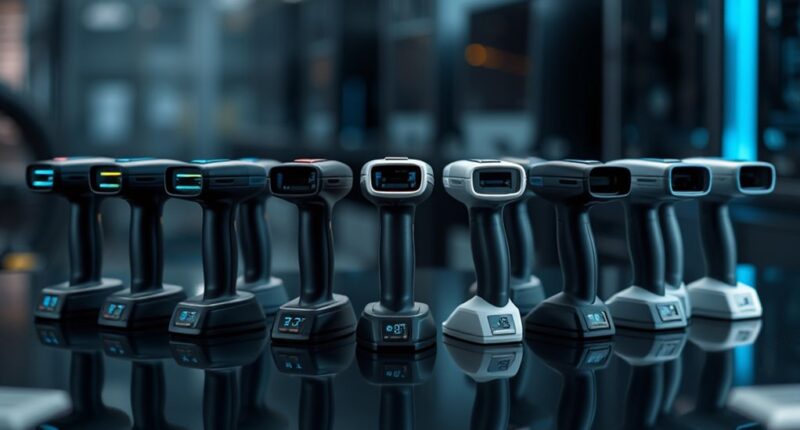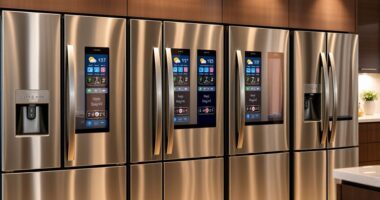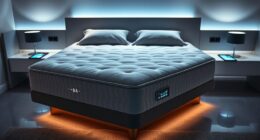If you’re looking for the 15 best 3D scanners of 2025, I’ve found some incredible options that excel in accuracy, speed, and portability. From handheld models like the Creality CR-Ferret SE and EINSTAR Rockit to versatile devices like the Revopoint MetroX and MIRACO Plus, these scanners handle complex surfaces and outdoor conditions with ease. Keep exploring; I’ll guide you through each top choice and what makes them stand out.
Key Takeaways
- The top 3D scanners in 2025 feature high accuracy, fast scanning speeds, and versatile surface compatibility for professional and industrial applications.
- Many models offer wireless connectivity, lightweight design, and multi-platform software support for efficient workflow integration.
- Advanced outdoor stability and ability to scan challenging surfaces, including shiny and reflective objects, are common among leading devices.
- High-resolution color and texture capture enhance realism, making these scanners ideal for detailed 3D modeling and visualization.
- These scanners cater to diverse needs, from high-precision manufacturing to quick, portable scanning for creative, industrial, and outdoor use.
Creality CR-Ferret SE 3D Scanner

If you’re looking for a portable, high-precision 3D scanner that’s easy to use, the Creality CR-Ferret SE is an excellent choice. Weighing just 105g, it’s compact and lightweight, making it perfect for on-the-go scanning. Its high-resolution 2MP color camera captures intricate details with 0.1mm accuracy, even in challenging lighting or on dark, metallic surfaces. Compatible with Mac, Windows, Android, and iOS, it supports quick setup with simple click operations. Designed for both beginners and professionals, it offers stable, high-quality scans thanks to advanced anti-shake technology and intelligent algorithms, ensuring reliable results in diverse environments.
Best For: professionals and hobbyists seeking a portable, high-precision 3D scanner that offers quick setup and reliable results across various environments.
Pros:
- Compact and lightweight design weighing only 105g for easy portability
- High-precision 0.1mm accuracy with full-color 2MP imaging for detailed, lifelike 3D models
- Advanced anti-shake technology and intelligent algorithms ensure stable, accurate scans even outdoors
Cons:
- Requires compatible devices with specific OS versions and hardware for optimal performance
- May have a learning curve for complete beginners unfamiliar with 3D scanning workflows
- Limited to the specifications of its optical and camera technology, potentially less effective on very large or highly reflective objects
Creality 3D Scanner CR-Scan Ferret Pro for 3D Printing
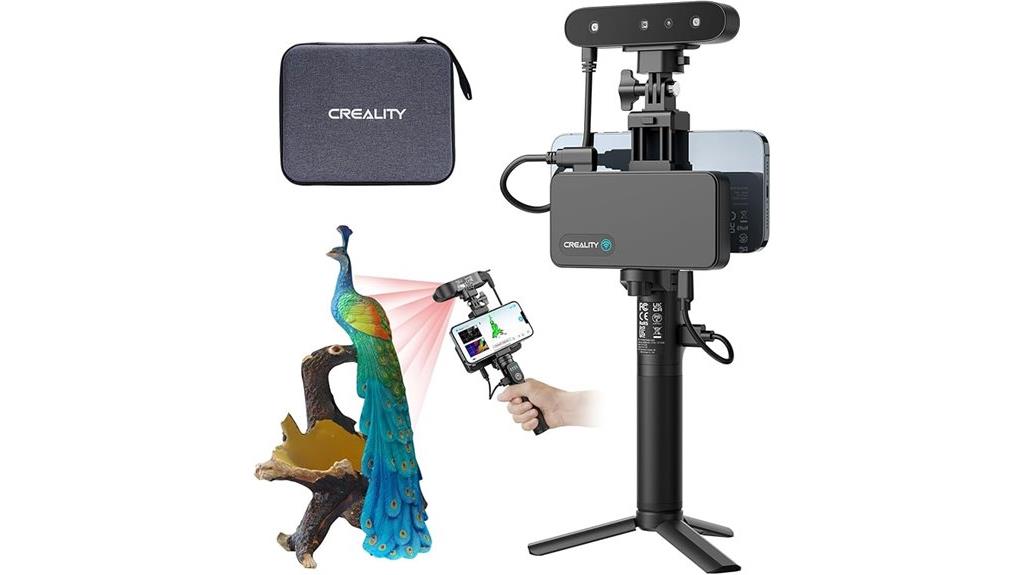
The Creality CR-Scan Ferret Pro stands out for anyone seeking high-precision, full-color 3D scans with exceptional portability. Weighing just 105 grams, it’s perfect for on-the-go scanning in any lighting condition, including sunlight. Its 0.1mm accuracy, anti-shake tracking, and wireless scanning via WiFi6 make capturing detailed models effortless. Compatible with iOS, Android, Windows, and macOS, it supports various output formats like OBJ, STL, and PLY. The device’s user-friendly design, along with accessories such as a WiFi box and carrying case, guarantees a seamless experience for professionals and hobbyists alike.
Best For: hobbyists, professionals, and educators seeking portable, high-precision, full-color 3D scanning capabilities compatible with multiple devices and operating systems.
Pros:
- Ultra-lightweight design (105 grams) ensures easy portability for on-the-go scanning
- High accuracy (0.1mm) and full-color detail with 24-bit color depth for detailed models
- Wireless scanning via WiFi6 supports fast, seamless connectivity across iOS, Android, Windows, and macOS
Cons:
- Mixed reviews with a 3.6-star rating may indicate some user experience variability
- Requires specific hardware configurations for optimal performance on Windows and macOS systems
- Limited information on long-term durability and battery life in the provided data
EINSTAR Rockit Wireless Laser 3D Scanner
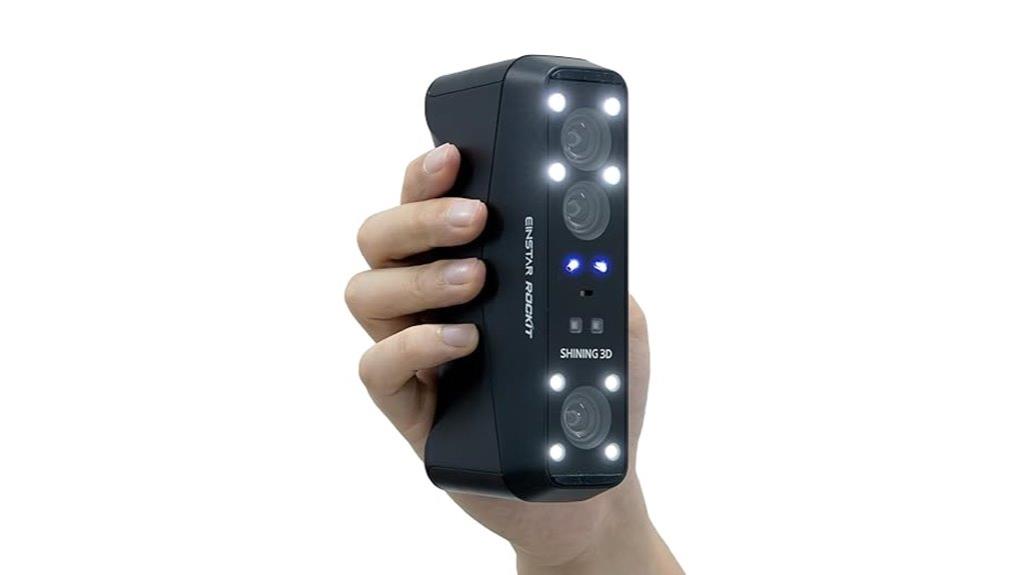
Designed for professionals who need fast, accurate 3D scans in outdoor and industrial environments, the EINSTAR Rockit Wireless Laser 3D Scanner stands out with its versatile laser modes and wireless portability. It offers multiple laser modes, including a blue laser with 38 lines for rapid large-area capture and 7 lines for detailed features, plus infrared and hybrid scanning options that work reliably outdoors in bright light. Its compact, pocket-sized design supports Wi-Fi for real-time data transfer, with a swappable battery lasting up to 3 hours. Capable of high-frame-rate capture and producing high-quality point clouds, it’s ideal for outdoor, daylight scanning of complex objects.
Best For: professionals needing fast, accurate outdoor and industrial 3D scanning with wireless portability and versatile laser modes.
Pros:
- Wireless operation with stable real-time data transfer via Wi-Fi for enhanced mobility and convenience
- Multiple laser modes, including blue laser with 38 lines and infrared options, for adaptable scanning on various surfaces and lighting conditions
- Compact, portable design with a swappable battery supporting up to 3 hours of continuous use, ideal for fieldwork
Cons:
- Requires a high-performance PC with at least 64 GB RAM for optimal software operation and workflow efficiency
- May have a learning curve for users unfamiliar with advanced laser scanning modes and software integration
- Potentially higher cost compared to basic or less versatile 3D scanners on the market
Revopoint MetroX 3D Scanner for 3D Printing

For professionals seeking high-precision 3D scanning for printing and industrial applications, the Revopoint MetroX stands out with its industrial-grade blue laser technology and accuracy up to 0.02 mm. It uses a Class 2M laser projector and 14 crossed blue laser lines, supporting dark or shiny surfaces without spray. With a scanning speed of up to 60 fps and four modes—including Auto Turntable for automated, metrology-grade scans—it delivers detailed point clouds and color data. Compatible with Windows and macOS, it’s ideal for reverse engineering, quality control, and high-precision manufacturing, all packed into a compact, desktop-friendly design.
Best For: professionals in industrial design, reverse engineering, quality control, and high-precision 3D printing seeking accurate, reliable, and versatile 3D scanning solutions.
Pros:
- High accuracy of up to 0.02 mm with industrial-grade blue laser technology ensures detailed and precise scans.
- Supports multiple scanning modes, including Auto Turntable, for automated, high-precision, metrology-grade captures.
- Compatible with Windows and macOS, and capable of handling dark or shiny surfaces without spray, enhancing versatility.
Cons:
- Software is limited to x86_64 architecture, potentially restricting compatibility with some systems.
- The laser projector, classified as Class 2M, requires caution to avoid direct eye contact at close range.
- The device’s advanced features and software may require a learning curve for new users.
Revopoint MIRACO Plus 3D Scanner for 3D Printing

If you need a versatile 3D scanner capable of capturing intricate details on both small and large objects, the Revopoint MIRACO Plus stands out as an excellent choice for 3D printing enthusiasts and professionals. It combines photogrammetric metrology with high-precision optics, achieving a length accuracy of 0.02 mm + 0.05 mm x L. Its quad-depth camera supports diverse scanning needs, from tiny screws to large machinery, while infrared zoom enhances surface detail. With a 48MP RGB camera, infrared laser safety, and powerful hardware including an 8-core processor and 32GB RAM, it delivers fast, accurate scans. Its lightweight design and all-encompassing software streamline workflows for creating high-quality 3D models.
Best For: professionals and enthusiasts seeking a versatile, high-precision 3D scanner for detailed small and large object capture suitable for 3D printing, reverse engineering, and product design.
Pros:
- High-precision photogrammetric metrology with 0.02 mm + 0.05 mm x L accuracy for detailed scans
- Supports diverse scanning modes and high-resolution color capture with a 48MP RGB camera and infrared zoom
- Portable and lightweight design with fast charging, long battery life, and comprehensive software support for seamless workflow integration
Cons:
- Relatively high cost may be a barrier for casual users or hobbyists
- Heavy reliance on software and hardware compatibility, which may require technical setup for optimal performance
- Advanced features and accessories might be overwhelming for beginners unfamiliar with 3D scanning technology
Shining 3D Einstar Handheld 3D Scanner

The Shining 3D Einstar Handheld 3D Scanner stands out for its high-density data capture and vibrant color fidelity, making it an excellent choice for professionals who need detailed, accurate scans. It collects high-resolution point clouds with a point distance of up to 0.1mm and captures vivid colors with its built-in RGB camera. The scanner supports fast scanning at 14 FPS, with features like automatic alignment and detailed enhancement technology that ensure top-quality results. Its outdoor stability, thanks to infrared projectors and stereo cameras, makes it versatile for various environments. Whether for art, design, or archiving, Einstar offers a streamlined workflow and broad compatibility.
Best For: professionals and educators seeking high-precision, vibrant 3D scans for art, design, archiving, and industrial applications.
Pros:
- High-density point cloud data with up to 0.1mm point distance for detailed scans
- Vibrant color capture with built-in RGB camera ensuring color fidelity
- Fast scanning speed of 14 FPS with automatic alignment and user-friendly workflow
Cons:
- May require familiarity with 3D software for optimal post-processing
- Potentially higher cost compared to entry-level scanners
- Performance can be affected in extremely bright outdoor conditions despite stability features
EINSTAR Rockit Wireless 3D Handheld Scanner with Tracker Accessories

Designed for professionals who need fast, reliable 3D scans in diverse environments, the EINSTAR Rockit Wireless 3D Handheld Scanner stands out with its advanced hybrid laser system and real-time wireless connectivity. It uses 38 blue laser lines for rapid, large-area scanning and 7 parallel lines for detailed capture, capable of scanning black or reflective surfaces without spray. Its infrared VCSEL technology allows safe, quick scans within 60 seconds, even outdoors in bright light up to 110,000 Lux. With markerless scanning, vivid texture capture, and a swappable battery providing up to 3 hours, it’s perfect for outdoor, industrial, and creative projects.
Best For: Professionals in industrial, artistic, and outdoor environments seeking fast, accurate, and versatile 3D scanning solutions.
Pros:
- Rapid large-area scanning with 38 blue laser lines and detailed capture via 7 parallel laser lines.
- Effective in bright outdoor conditions up to 110,000 Lux, suitable for outdoor object scanning.
- Markerless scanning with vivid texture capture and real-time wireless connectivity for seamless workflow integration.
Cons:
- May require familiarity with advanced 3D scanning technology for optimal use.
- Battery life of up to 3 hours might necessitate additional power management for extended sessions.
- High-quality features might come at a premium price point compared to basic scanners.
Creality CR-Ferret SE 3D Scanner for 3D Printing
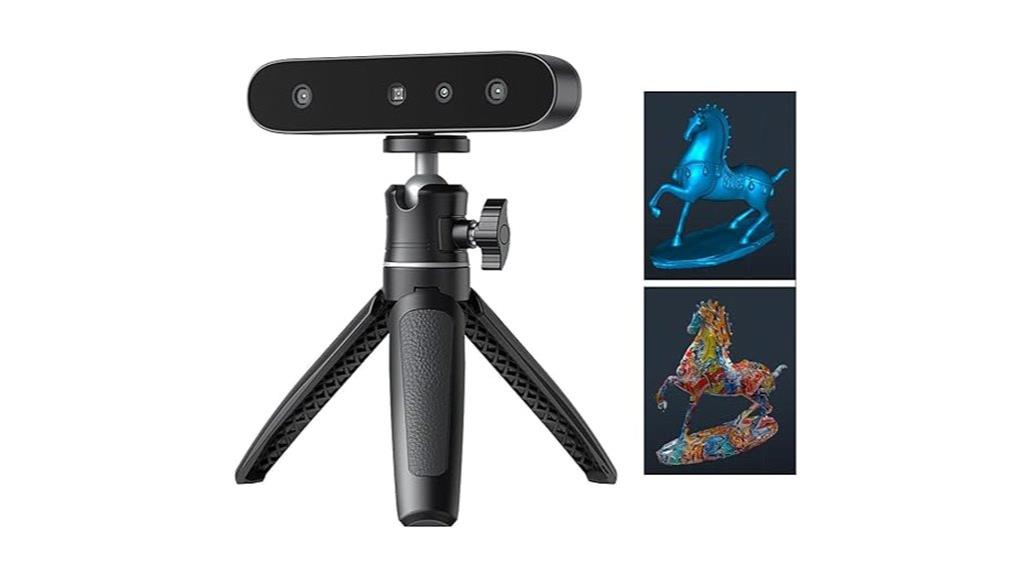
Looking for a 3D scanner that combines high accuracy with quick, reliable results? The Creality CR-Ferret SE delivers just that, with up to 0.1mm accuracy and a resolution of 0.16mm, all at 30FPS. Its one-shot imaging technology makes scanning smooth and efficient, even for beginners, and it handles shaky hands or rapid movements flawlessly. The built-in 2MP color camera captures vivid textures and true-to-life colors, while its flexible range from 150mm to 2000mm allows for scanning medium to large objects easily. Plus, it’s optimized for black and metal surfaces, eliminating the need for messy sprays.
Best For: Beginners and professionals seeking quick, highly accurate 3D scans of medium to large objects with vivid color and texture details.
Pros:
- Highly accurate scanning up to 0.1mm with detailed resolution of 0.16mm.
- Fast scanning speed of 30FPS combined with one-shot imaging technology for efficient results.
- Captures vivid full-color textures, bringing models to life with true-to-color details.
Cons:
- May be less effective on very small objects below 150mm without adjustments.
- Limited information on compatibility with certain 3D software or hardware ecosystems.
- Potential cost considerations for users seeking basic or entry-level scanners.
Revopoint MetroY Pro 3D Scanner for 3D Printing

If you need a high-precision 3D scanner capable of handling complex and detailed objects for professional 3D printing, the Revopoint MetroY Pro stands out as an excellent choice. It offers industrial-grade accuracy with blue lasers, capturing details up to 0.01mm and ensuring volumetric accuracy of 0.02mm + 0.04mm x L. With five scanning modes, including surface, detailed, deep hole, ultra-fast structured light, and auto turntable, it handles shiny and dark surfaces without spray. Its wireless Wi-Fi 6 connectivity, fast speeds, and marker-free, fast workflows make it ideal for reverse engineering, metrology, and high-quality 3D printing.
Best For: professionals and hobbyists seeking high-precision 3D scanning for complex objects, reverse engineering, and high-quality 3D printing workflows.
Pros:
- Industrial-grade accuracy with detailed capture up to 0.01mm and volumetric accuracy of 0.02mm + 0.04mm x L
- Supports multiple scanning modes including surface, detailed, deep hole, and ultra-fast structured light, handling shiny and dark surfaces without spray
- Wireless Wi-Fi 6 connectivity enables real-time streaming, live control, and fast, marker-free workflows
Cons:
- macOS software support is upcoming, which may limit immediate compatibility for Mac users
- The device and accessories may be relatively expensive compared to entry-level scanners
- Requires a stable Wi-Fi connection for optimal wireless performance, which might be challenging in certain environments
Creality 3D Scanner CR-Scan Raptor Pro

The Creality 3D Scanner CR-Scan Raptor Pro stands out for professionals and industrial users who need metrology-grade accuracy combined with versatile scanning capabilities. It delivers an impressive 0.02mm resolution and volumetric accuracy of 0.02mm+0.08mm/m, making it ideal for detailed inspections. Its multi-mode system uses 22 blue laser lines and 7 infrared structured light modes, enabling precise scans of objects from 5mm to 4 meters. It handles challenging surfaces like dark, reflective metals, and automotive glass. Fast, capturing at 60 frames per second, it works well indoors and outdoors, even in bright conditions, ensuring reliable high-quality data.
Best For: professionals and industrial users requiring high-precision, versatile 3D scanning for detailed inspections, quality control, and complex object capturing.
Pros:
- Metrology-grade accuracy with 0.02mm resolution and volumetric accuracy of 0.02mm+0.08mm/m
- Multi-mode scanning system with 22 blue laser lines and 7 infrared structured light modes for versatile applications
- Fast data capture at 60 frames per second, suitable for both indoor and outdoor use in bright conditions
Cons:
- Requires compatible hardware with specific system requirements for optimal performance
- May involve a learning curve for new users to fully utilize advanced features
- Higher cost compared to entry-level or less precise 3D scanners
Creality CR-Scan Ferret Pro 3D Scanner
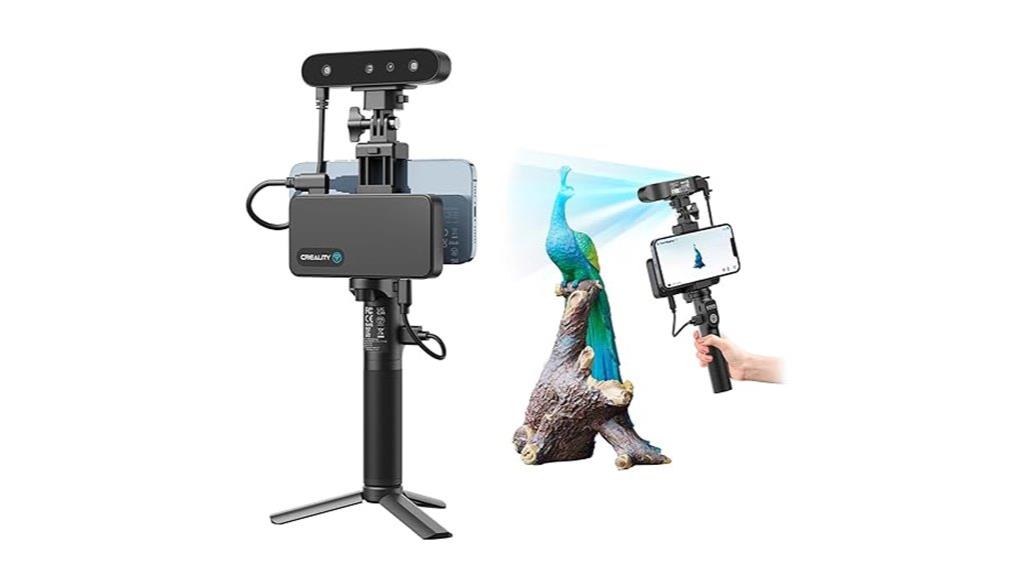
For professionals seeking high-precision 3D scans with vibrant textures, the Creality CR-Scan Ferret Pro stands out thanks to its 0.1mm accuracy and 2MP color camera. It captures detailed, realistic models at 30FPS, making it ideal for complex shapes and larger objects within a 150–2000mm range. Its high-resolution camera delivers vivid textures, while WiFi 6 ensures fast, stable data transfer. The scanner’s enhanced outdoor capabilities and anti-shake features make it versatile and user-friendly, even in sunlight. Compatible with Windows, Mac, Android, and iOS, it offers reliable performance for professionals and beginners alike.
Best For: professionals and enthusiasts needing high-precision, vibrant-texture 3D scans of medium to large objects in various environments, including outdoor settings.
Pros:
- High accuracy of 0.1mm and 2MP color camera deliver detailed, realistic models with vivid textures.
- Fast data transfer with WiFi 6 ensures efficient workflow and stable outdoor scanning.
- Versatile design with enhanced outdoor capabilities and anti-shake features makes it suitable for diverse environments.
Cons:
- Requires a relatively powerful system with specific hardware (e.g., Windows i5-Gen8 or later, Mac M1/M2), which may limit some users.
- The maximum scanning range of 150–2000mm might not suit very small or extremely large objects.
- The device’s advanced features and technology could lead to a higher price point, potentially limiting accessibility for casual users.
Revopoint Inspire 2 3D Scanner for 3D Printing

Designed for professionals who demand high precision and versatility, the Revopoint Inspire 2 3D Scanner stands out with its remarkable 0.03mm accuracy, making it perfect for detailed 3D printing, reverse engineering, and intricate modeling projects. It’s compatible with iOS, Android, and Windows, with wireless connectivity via WiFi 6.0 for remote operation and real-time streaming. Weighing only 190g, its lightweight, aerospace-grade aluminum design guarantees durability and portability. Equipped with dual scanning modules—infrared structured light and multi-line laser—it captures challenging surfaces without spray, while the built-in RGB camera delivers true-to-life color textures for exhaustive digital models.
Best For: professionals seeking high-precision, portable 3D scanning solutions for detailed 3D printing, reverse engineering, and complex modeling projects.
Pros:
- Achieves up to 0.03mm accuracy for detailed and precise models
- Wireless connectivity via WiFi 6.0 allows remote operation and real-time streaming
- Lightweight (190g) with durable aerospace-grade aluminum for portability and robustness
Cons:
- May require familiarity with 3D scanning software for optimal use
- Higher price point compared to basic scanners for casual users
- Performance can be affected in extremely bright outdoor environments without proper filters
Creality 3D Scanner CR-Scan Ferret for 3D Printing
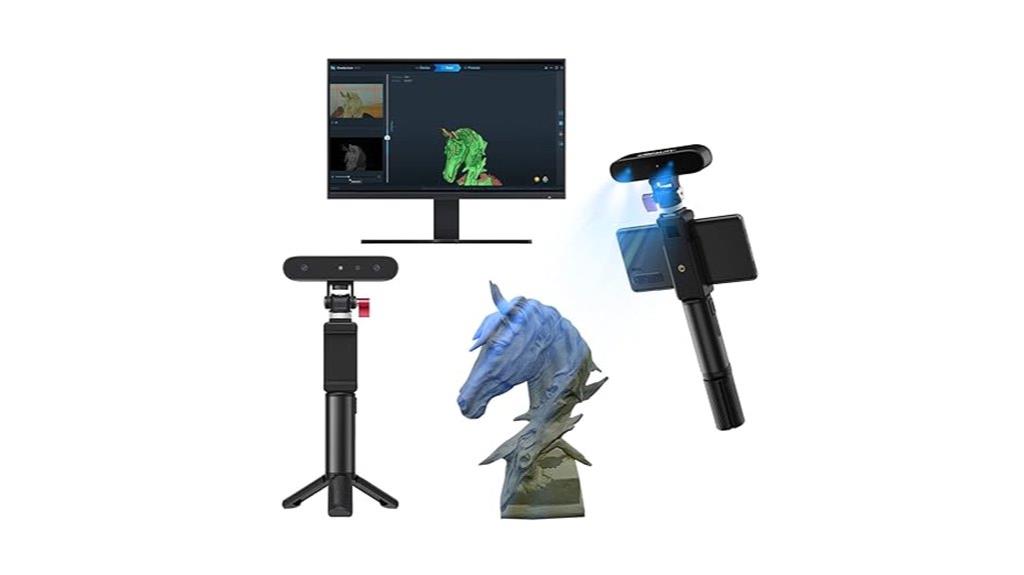
If you need a portable 3D scanner that delivers high accuracy and vibrant color detail, the Creality 3D Scanner CR-Scan Ferret is an excellent choice. It offers handheld scanning at 30 FPS with 0.1mm precision and full-color capture, making it ideal for detailed 3D printing and modeling. Its dual-mode scanning supports both wide-range and high-accuracy modes, while the ASIC chipset ensures fast, smooth results. Compatible with Android, Windows, and Mac OS devices, it’s easy to connect via Wi-Fi 6. The built-in high-res camera and improved firmware make it a versatile, user-friendly tool, perfect for capturing intricate objects on the go.
Best For: 3D printing enthusiasts and digital content creators seeking portable, high-precision, full-color 3D scanning solutions for detailed object capture.
Pros:
- Fast 30 FPS handheld scanning with 0.1mm accuracy for high-quality 3D models
- Full-color texture capture enhances model realism and visual appeal
- Compatible with multiple platforms (Android, Windows, Mac OS) and supports Wi-Fi 6 connectivity for flexible use
Cons:
- Requires specific system configurations (e.g., Windows i5-Gen8+, Mac OS 11.7.7+) for optimal performance
- Limited to 0.1mm accuracy, which may not suffice for ultra-precision industrial needs
- Slightly higher cost compared to basic 3D scanners due to advanced features and software capabilities
Creality CR-Scan Ferret Pro 3D Scanner

The Creality CR-Scan Ferret Pro 3D Scanner stands out with its impressive 0.1mm accuracy and fast scanning speeds, making it ideal for professionals and serious hobbyists who demand high precision. Its anti-shake tracking and One-Shot 3D imaging technology ensure stable, smooth handheld scans, even on challenging surfaces like black or metal objects, without spray. It supports full-color 24-bit textures, capturing realistic details perfect for visualization or 3D printing. With WiFi6, it offers rapid wireless data transfer across multiple devices and operating systems. Its compact design, complete with accessories, makes it versatile for large and outdoor objects, delivering detailed, high-quality models every time.
Best For: professionals and serious hobbyists seeking high-precision, fast, and versatile 3D scanning for detailed models, visualization, and 3D printing projects.
Pros:
- High accuracy of 0.1mm ensures precise and detailed 3D scans.
- Fast scanning with anti-shake technology provides stable, smooth handheld operation.
- Supports full-color 24-bit textures and multiple output formats for realistic, versatile models.
Cons:
- May require a relatively powerful computer setup (Windows i5-Gen8+ or Mac M1/M2) for optimal performance.
- The initial cost might be high for casual users or hobbyists with limited budgets.
- Wireless setup and operation depend on WiFi6 compatibility, which might limit some older devices.
3DMakerpro Handheld 3D Scanner for 3D Printer

For professionals and hobbyists seeking high-precision 3D scanning for printing and modeling, the 3DMakerpro Handheld 3D Scanner stands out with its impressive 0.02mm accuracy and rapid scanning rate. It uses refined structured light technology with a shorter wavelength, capturing detailed models at 100,000 points per second. Compatible with Windows and MacOS, it supports multiple file formats like OBJ, STL, PLY, and ASC. The lightweight design (190g) and durable construction make it portable and easy to use on the go. Plus, features like optical stabilization and adjustable lighting guarantee smooth, precise scans in various environments.
Best For: professionals and hobbyists seeking high-precision, portable 3D scanning solutions compatible with various file formats and operating systems.
Pros:
- High accuracy of 0.02mm and fast scanning rate of 100,000 points per second for detailed models
- Compatible with Windows 10/11 and MacOS, supporting multiple export formats like OBJ, STL, PLY, and ASC
- Lightweight (190g), durable, and equipped with optical stabilization and adjustable lighting for versatile use in different environments
Cons:
- Requires optional Smart Grip accessory for smartphone connectivity, which may entail additional cost
- Slightly less robust construction compared to models with aluminum alloy bodies
- May have a learning curve for beginners unfamiliar with 3D scanning software and workflows
Factors to Consider When Choosing 3D Scanners

When selecting a 3D scanner, I look at several key factors to guarantee it meets my needs. Things like accuracy, scanning range, and compatibility can make a big difference in performance. Understanding these points helps me choose the right tool for my projects.
Accuracy and Precision
Choosing a 3D scanner with high accuracy and precision is vital because these factors determine how detailed and reliable your digital models will be. Higher accuracy, often measured in 0.02mm or better, ensures your scans are true to the actual object, which is essential for engineering, quality control, and design. Precision reflects the scanner’s ability to reproduce consistent measurements, minimizing errors and increasing trust in the data. The resolution of the optical system also affects the level of detail, capturing smaller surface features effectively. Keep in mind that environmental conditions such as lighting and surface reflectivity can influence accuracy and precision, especially on dark or shiny surfaces. Prioritizing these qualities ensures you get precise, dependable scans for your professional needs.
Scanning Range and Size
The scanning range of a 3D scanner directly impacts its ability to capture objects of different sizes effectively. It determines the maximum size of objects that can be scanned in a single pass, ranging from just a few centimeters to several meters. When choosing a scanner, I consider whether its minimum and maximum range match my typical project sizes to guarantee efficient data capture. Some scanners offer adjustable or flexible ranges, making them versatile for both small, detailed parts and large structures. The capture area, usually specified in width and height, influences how much of an object I can scan at once without repositioning. For larger objects, I look for scanners with broad ranges or that support stitching multiple scans seamlessly to produce complete, high-quality models.
Material Compatibility
Material compatibility is essential because not all 3D scanners can accurately capture every surface type, especially challenging ones like shiny metals or transparent plastics. When choosing a scanner, I look for models that handle various materials without surface prep or spray coatings. It’s important that the device supports dark, shiny, or transparent surfaces, often requiring advanced optical technology or multi-mode laser systems. A good scanner should have optical sensors and light sources capable of recording textures and colors across different materials, including full-color, high-resolution textures. I also check if the hardware and software can adapt to complex or reflective surfaces, ensuring high fidelity and precision. This compatibility guarantees accurate, detailed scans regardless of the material, saving time and delivering reliable results.
Portability and Design
When selecting a 3D scanner, portability and design play a crucial role in guaranteeing ease of use across different environments. A lightweight, compact design makes it simple to carry and operate in various settings, from indoor labs to outdoor sites. Ergonomic shapes and portable form factors allow for comfortable handheld use, reducing fatigue during long scanning sessions. Wireless connectivity options like WiFi or Bluetooth cut down on cables, making setup quick and hassle-free. Durable materials ensure the scanner withstands frequent transport and outdoor conditions without damage. Additionally, foldable or modular designs enhance portability by enabling compact storage or customization for specific tasks. Overall, thoughtful design choices can markedly improve convenience, flexibility, and efficiency in your 3D scanning experience.
Connectivity Options
Choosing the right connectivity options is essential for ensuring smooth data transfer and seamless integration with your devices. I consider whether a scanner offers wired options like USB or Ethernet, which provide stable, low-latency connections ideal for large or high-precision projects. Wireless options such as Wi-Fi or Bluetooth offer convenience, especially in dynamic environments. Wi-Fi 6, in particular, delivers faster speeds and lower latency, making high-resolution scans more efficient. I also check compatibility with my devices and operating systems to avoid integration issues. Additionally, supporting multiple device connections simultaneously can boost productivity in collaborative settings. Ultimately, selecting the right connectivity depends on your workspace, project complexity, and whether you prioritize stability or flexibility.
Software Capabilities
Selecting a 3D scanner with robust software capabilities is vital for maximizing your workflow and achieving high-quality results. I look for software that supports multiple file formats like OBJ, STL, PLY, and ASC, guaranteeing compatibility with various design and printing programs. Advanced editing, meshing, and post-processing tools are essential for refining scans and preparing models efficiently. Features like automatic alignment, feature recognition, and real-time feedback help improve scan accuracy and speed up the process. I also prioritize software that’s compatible with Windows and macOS, and mobile app support adds flexibility. Additionally, calibration, error correction, and cloud integration streamline workflows and make data management easier. These capabilities guarantee I get precise, professional results with less hassle.
Environment Suitability
To guarantee reliable performance across various environments, I look closely at a 3D scanner’s ability to operate outdoors under different lighting conditions. Bright sunlight and high ambient light levels can challenge data accuracy, so I check the scanner’s maximum Lux ratings—some models handle up to 110,000 Lux, making them suitable for outdoor use. I also consider whether the scanner employs infrared or hybrid laser technologies, which improve performance on reflective or dark surfaces and enhance outdoor adaptability. Environmental robustness is key; the scanner should resist dust, moisture, and temperature changes for field use. Additionally, I verify it can produce stable, precise scans despite vibrations or uneven surfaces, ensuring consistent results in real-world conditions.
Frequently Asked Questions
How Do 3D Scanner Accuracy Levels Impact Print Quality?
Higher accuracy levels in 3D scanners directly improve print quality by capturing finer details and reducing errors. When I use a precise scanner, I notice smoother surfaces, sharp edges, and true-to-original models. Lower accuracy can lead to distortions or missing features, which compromise the final print. So, investing in a high-accuracy scanner guarantees I get reliable, high-quality 3D prints that match my designs perfectly.
What Are the Best Scanners for Small Object Detail?
If you’re focusing on small object detail, I recommend the EinScan-SE or the Artec Eva. They excel at capturing intricate features with high resolution, making them perfect for jewelry, miniatures, or detailed prototypes. I’ve used both, and their precision really stands out. They’re user-friendly too, so you don’t need to be a tech expert to get great results. Trust me, they’ll elevate your small-scale 3D scanning projects.
How Does Scanning Speed Vary Among Top Models?
I know speed matters when scanning, and the top models vary quite a bit. Some can capture detailed objects in just a few seconds, making workflows faster and more efficient. Others take longer, especially with complex shapes or high-resolution settings. I’ve seen models that scan in under a minute, allowing me to work quickly, while others might need several minutes. It’s exciting how technology keeps improving, making scanning faster and more accessible.
Are Portable Scanners Suitable for Professional Use?
Absolutely, portable scanners are suitable for professional use, especially when flexibility and on-the-go scanning are priorities. I’ve found them perfect for fieldwork, quick inspections, and on-site modeling, without sacrificing accuracy. While some high-end models match desktop scanners in precision, I recommend choosing a portable one that aligns with your specific needs, balancing ease of use with the required resolution and range for your projects.
What Maintenance Is Needed for Long-Term Scanner Performance?
I believe regular maintenance keeps my 3D scanner performing at its best. I clean the lenses and sensors with a soft, lint-free cloth weekly to prevent dust buildup. I also update the firmware when needed and store the scanner in a dry, dust-free environment. Checking cables and connections periodically helps avoid glitches. This routine guarantees my scanner stays accurate and reliable over the long term, just like a well-maintained tool.
Conclusion
So, as you navigate this maze of cutting-edge 3D scanners, think of me as your trusty compass guiding you through a digital jungle. Each device is a shining star in the vast night sky, ready to illuminate your creative journey. With the right choice, you’ll reveal endless possibilities—like finding the missing piece in your masterpiece. Let these tools be your magic wand, transforming ideas into reality with a flick.
